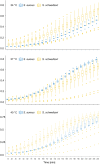An in vitro study on Staphylococcus schweitzeri virulence
- PMID: 33442048
- PMCID: PMC7806826
- DOI: 10.1038/s41598-021-80961-x
An in vitro study on Staphylococcus schweitzeri virulence
Abstract
Staphylococcus schweitzeri belongs to the Staphylococcus aureus-related complex and is mainly found in African wildlife; no infections in humans are reported yet. Hence, its medical importance is controversial. The aim of this work was to assess the virulence of S. schweitzeri in vitro. The capacity of African S. schweitzeri (n = 58) for invasion, intra- and extracellular cytotoxicity, phagolysosomal escape, coagulase activity, biofilm formation and host cell activation was compared with S. aureus representing the most common clonal complexes in Africa (CC15, CC121, CC152). Whole genome sequencing revealed that the S. schweitzeri isolates belonged to five geographical clusters. Isolates from humans were found in two different clades. S. schweitzeri and S. aureus showed a similar host cell invasion (0.9 vs. 1.2 CFU/Vero cell), host cell activation (i.e. expression of pro-inflammatory cytokines, 4.1 vs. 1.7 normalized fold change in gene expression of CCL5; 7.3 vs. 9.9 normalized fold change in gene expression of IL8, A549 cells) and intracellular cytotoxicity (31.5% vs. 25% cell death, A549 cells). The extracellular cytotoxicity (52.9% vs. 28.8% cell death, A549 cells) was higher for S. schweitzeri than for S. aureus. Nearly all tested S. schweitzeri (n = 18/20) were able to escape from phagolysosomes. In conclusion, some S. schweitzeri isolates display virulence phenotypes comparable to African S. aureus. S. schweitzeri might become an emerging zoonotic pathogen within the genus Staphylococcus.
Conflict of interest statement
The authors declare no competing interests.
Figures



References
-
- Tong SY, et al. Novel staphylococcal species that form part of a Staphylococcus aureus-related complex: The non-pigmented Staphylococcus argenteus sp. nov. and the non-human primate-associated Staphylococcus schweitzeri sp. nov. Int. J. Syst. Evol. Microbiol. 2015;65:15–22. doi: 10.1099/ijs.0.062752-0. - DOI - PMC - PubMed
-
- Becker K, et al. Implications of identifying the recently defined members of the Staphylococcus aureus complex S. argenteus and S. schweitzeri: A position paper of members of the ESCMID Study Group for Staphylococci and Staphylococcal Diseases (ESGS) Clin. Microbiol. Infect. 2019;1:1. doi: 10.1016/j.cmi.2019.02.028. - DOI - PubMed
Publication types
MeSH terms
Supplementary concepts
LinkOut - more resources
Full Text Sources
Other Literature Sources
Medical
Molecular Biology Databases

